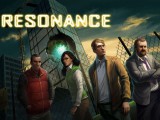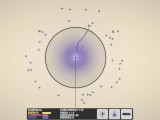I’m not a big strategy gamer, in general, but I’m fascinated by both turn-based and real-time strategy games. I like the idea of a world simulated on a macro level, in which units and vehicles and structures all interact in the tens, hundreds, thousands. So even though I don’t quite have the tactical mind required to keep control of the vast numbers of entities, I still am intrigued by seeing the results of my strategizing and planning unfolding before me, complex and unpredictable.
But I also like the simple, the minimal. I love small indie games, with the most rudimentary visuals and focused purely on gameplay. The more successful ones often employ clever techniques to produce appealing graphics to overcome the lack of manpower and budget.
Dyson is described by its developers Rudolf Kremers and Alex May as an “ambient real-time strategy game with abstract visuals”. Originally created in one month for submission to a procedural generation competition at TIGSource a couple of years back, the game quickly caught the attention of the community and soon was nominated for awards at the Independent Games Festival. The team have expressed plans to expand on the game and so continue to update the build on their site - the current version available being the one they showcased at IGF.
The game revolves around taking control over an asteroid belt. A belt consists of a number of asteroids of differing sizes and attributes, each of which the player must colonise. This is done by using the one controllable unit, the seedling, and planting either Dyson trees, which produce more seedlings, or defensive trees, which produce homing explosive pods to defend the asteroid from enemy seedlings. Hence colonisation of a map is node-based, similar in way to Sins of a Solar Empire. An asteroid’s attributes determine the kind of seedlings that are produced on it, and consist of varying amounts of energy, strength and speed. Strategy is involved in keeping seedlings in orbit around an asteroid to defend it as its trees grow and sending them off to other asteroids to attack enemies and conquer territory. Everything can be accomplished with just the mouse; zooming in and out of the map centers on the mouse cursor just like in Sins, and all commands are executed with the left and right mouse buttons and onscreen UI.
The game sports a unique look with its abstract visuals. Most of the content in the game is procedurally generated, evident in the appearance of the asteroids, trees and seedlings, which change in colour and detail with every game you play. The music is mostly ambiance, consisting mostly of sounds and textures and only occasionally percussion or chords, and changes with context. The result is a refreshingly new and distinct style that is easy on the eyes and ears, a minimalist aesthetic like something right out of Introversion’s book.
Dyson is a relaxing and pleasant experience, but there are still things about it that really need work especially if the team intends to go commercial1 and provide more than a light diversion. The controls, simple as they are, could use a revision. Sending seedlings to other asteroids involves first right-clicking the number of seedlings required, and then left-clicking to deploy them. Asteroids soon amass large quantities of units, and then you can either choose to send them all off with one click and drag, or a specific number with a bunch of repeated clicks. The clickiness is cumbersome and is irritating in heightened situations when you need to act swiftly. The game also tends to devolve into the same kind of endgame with each play. There are a number of ‘levels’ which are scenarios with particular set-ups of starting asteroids and enemies, but they don’t do much to differentiate the gameplay. Your approach can be exactly the same for each one and nothing compels you to change your strategy. If the developers can provide some more factors in the mechanics and maps that will allow for more varied gameplay, Dyson could prove to be an indie title worth paying for.
- http://tigsource.com/articles/2009/04/18/tiginterview-rudolf-kremers [↩]









Excellent concept. Bit on the slow side and still of lot of tweaking and bug issues though.